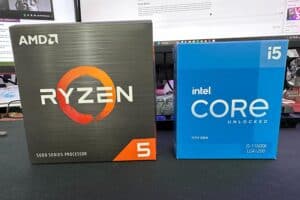Ryzen 9 7900X3D vs i9-13900K
Ryzen 9 7900X3D vs i9-13900K, which is better?

WePC is reader-supported. When you buy through links on our site, we may earn an affiliate commission. Prices subject to change. Learn more
The Ryzen 9 7900X3D is finally out, and things are looking good for AMD’s long-awaited X3D CPU release. In this article, we’re comparing the Ryzen 9 7900X3D with one of Intel’s top processors, the Core i9-13900K. This is Ryzen 9 7900X3D vs i9-13900K.
Now read: Is Ryzen 7000X3D worth it
Ryzen 9 7900X3D vs i9-13900K: CPU specs
Before we get into all the details, let’s briefly look at the official specs for both processors so we know what we’re working with.
AMD Ryzen 9 7900X3D
- Core count: 12 (Multithreading enabled)
- Thread count: 24
- Clock speed: 4.4GHz
- Boost clock speed: 5.6GHz
- L2 cache: 12MB
- L3 cache: 128 MB
- TDP: 120 watts
- iGPU: Radeon Graphics
- Socket: AM5
Intel Core i9-13900K
- P-cores: 8 (Hyperthreading enabled)
- E-cores: 16
- Thread count: 32
- P.core clock speed: 3.0 / 5.8 GHz
- E.core clock speed: 2.2 / 4.3 GHz
- L2 cache: 32MB
- L3 cache: 36MB
- Base TDP: 125W
- Max TDP: 253W
- iGPU: UHD770
- Socket: LGA1700
Ryzen 9 7900X3D and Intel Core i9-13900K compared
Let’s get the obvious differences out of the way first. The Ryzen 9 7900X3D is a 12-core, 24-thread processor built on the Zen 4 architecture.
The 13900K, on the other hand, features Intel’s hybrid core architecture and packs two different core types – one designed for performance and the other for power efficiency.
We see that the 13900K has the edge in raw clock speed, core count, and thread count. The only department where the 7900X3D is leading is the L3 cache; the new Ryzen processor features a massive 128MB cache size.
The 13900K has a healthy 36MB of cache in its own right. But of course, that pales in comparison to the Ryzen’s 128MB cache.
Gaming performance
Both processors offer powerful gaming performance, but the 7900X3D takes the edge here thanks to its V-cache enhancement.
The 13900K does lead slightly in singlethreaded performance, which is something we have known to be the primary dictator of gaming performance for a long time.
However, L3 cache size has become increasingly important lately as well. And, as we see with this comparison, the V-cache enhanced R9 7900X3D is able to consistently offer more frames in-game than the 13900K, despite having a lower maximum clock speed.
And the clock speed difference between the two processors is larger than it may seem initially. While the 13900K cores can boost all the way up to a 5.8GHz clock speed during gaming, the 7900X3D’s cores barely top 5GHz.
That’s because all game-related processing on the new Ryzen processor is carried out on the first 8-core CCD equipped with Vcache.
Unfortunately, V-cache is very temperature sensitive, so the boost clock for cores on this CCD had to be lowered for stability.
The 5.6GHz max clock speed listed in the specs can only be achieved by the 4 cores housed by the other CCD, which aren’t active during gaming but do pitch in to help out in heavy multicore workloads.
This just goes to show you how much of a difference V cache makes – the 7900X3D runs at a much lower clock speed than the 13900K while gaming but can still deliver more frames.
Workstation productivity
For workstation productivity, the 13900K is the clear winner. And to be fair, you would expect it to be. That’s because the 13900K has a remarkable 24 cores and 32 threads. By comparison, the R9 7900X3D has 12 cores and 24 threads.
Not only does the 13900K have more cores and threads, but each of these threads is also running at a higher clock speed than the 7900X3D’s when under full utilization. So the difference is pretty clear-cut in this case.
The extra V cache doesn’t really help out the Ryzen processor since typical productivity workloads don’t benefit from it to a remarkable degree.
Power usage and thermals
The Ryzen 9 7900X3D has a moderate 120-watt TDP. That’s decent, considering the performance offered. The 13900K can consume upwards of twice as much power, with a 253-watt max TDP.
The 7900X3D is the more power efficient of the two processors. Because both processors consume a fair amount of power in the first place, the energy savings offered by the 7900X3D can add up over time.
Final words
The difference between the two processors is pretty clear. The R9 7900X3D is the better gaming processor, whereas the 13900K offers more multithreaded performance, making it the better workstation processor for tasks like video editing, rendering, and media production.










